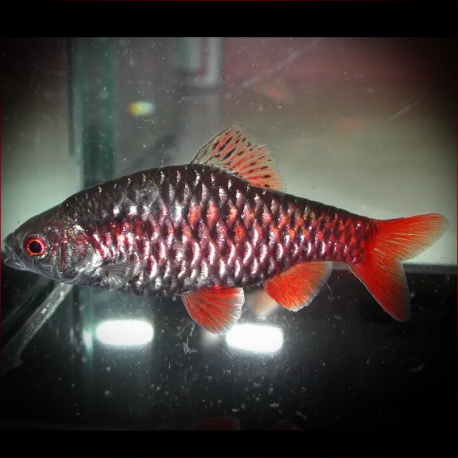More info
Datasheet
| Minimum Tank Size | 72 litres / 19.02 US gallons |
| Maximum Size | 6.2cm / 2.44inches |
| Temperature | 18°C / 64.40°F - 25°C / 77.00°F |
| Hardness | 2.02dgH / 36ppm - 15.02dgH / 268ppm |
| pH | 5.5-7.5 |
General Description
Pethia manipurensis, formerly known as Puntius manipurensis, is a small cyprinid fish species that is not commonly found in the aquarium trade outside of India. It belongs to the family Cyprinidae and is classified under the order Cypriniformes. Adult males are known for their vibrant colors, especially during the spawning season, displaying dark markings in the dorsal fin. The species is a schooling fish by nature, so it is recommended to keep at least 6-10 specimens to promote natural behavior and color development in males.
Aquarium Setup
When setting up an aquarium for Pethia manipurensis, a minimum tank size of 72 liters is recommended. The species thrives in a well-planted tank with a dark substrate and benefits from the addition of floating plants, driftwood, and leaf litter. Filtration should be gentle, and some water movement is appreciated. The water conditions should be maintained within a temperature range of 18-25°C, a pH range of 5.5-7.5, and a hardness of 36-268 ppm (see table).
Behaviour
Known for their peaceful nature, Pethia manipurensis makes an excellent addition to community aquariums. They can coexist with a variety of popular fish species, including other small cyprinids, tetras, livebearers, rainbowfish, catfish, and loaches. Keeping them in a group will not only reduce skittish behavior but also enhance the visual appeal of the tank. Males of the species develop better colors in the presence of conspecific rivals.
Feeding and Diet
In the wild, Pethia manipurensis feed on diatoms, algae, organic detritus, insects, worms, crustaceans, and zooplankton. In an aquarium setting, they readily accept a diet of small live and frozen foods such as bloodworms, Daphnia, and Artemia. High-quality dried flakes and granules with added plant or algal content should also be included in their diet for optimal health and coloration.
Reproduction & Dimorphism
Pethia manipurensis are egg-scattering free spawners with no parental care. Providing them with a separate breeding tank dimly lit and furnished with spawning sites such as mesh, spawning mops, or fine-leaved plants can help maximize fry yield. Adult males exhibit brighter colors and smaller size compared to females, especially during the breeding period, with distinct dark markings in the dorsal fin.
Habitat and Distribution
Endemic to Loktak Lake in Manipur state, northeastern India, Pethia manipurensis is considered an endangered species with a declining population trend. The lake faces challenges such as eutrophication, siltation, and habitat destruction due to human activities like deforestation and the spread of invasive plant species. The species is bred commercially for the aquarium trade, as its natural population in Loktak Lake remains under threat.

